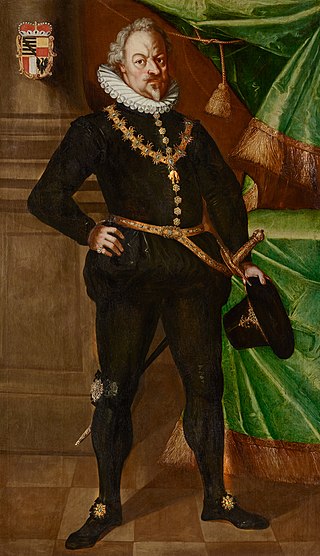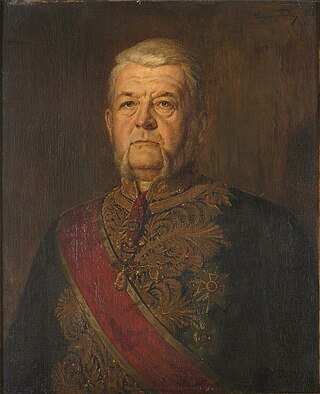
Liechtenstein is a principality governed under a semi-constitutional monarchy. It has a form of mixed constitution in which political power is shared by the monarch and a democratically elected parliament. There is a two-party system and a form of representative democracy in which the prime minister and head of government is responsible to parliament. However the Prince of Liechtenstein is head of state and exercises considerable political powers.

Belgium is a constitutional, hereditary and popular monarchy. The monarch is titled King of the Belgians and serves as the country's head of state and commander-in-chief of the Belgian Armed Forces. There have been seven Belgian monarchs since independence in 1830.

Hans-Adam II is the Prince of Liechtenstein. He is the son of Prince Franz Joseph II and his wife, Countess Georgina von Wilczek. He also bears the titles Duke of Troppau and Jägerndorf, and Count of Rietberg. Under his reign, a 2003 constitutional referendum expanded the powers of the Prince of Liechtenstein. In 2004, Hans-Adam transferred day-to-day governmental duties to his eldest son Hereditary Prince Alois as regent, like his father had granted him in 1984 to prepare him for the role.
In the United Kingdom, life peers are appointed members of the peerage whose titles cannot be inherited, in contrast to hereditary peers. Life peers are appointed by the monarch on the advice of the prime minister. With the exception of the Dukedom of Edinburgh awarded for life to Prince Edward in 2023, all life peerages conferred since 2009 have been created under the Life Peerages Act 1958 with the rank of baron and entitle their holders to sit and vote in the House of Lords, presuming they meet qualifications such as age and citizenship. The legitimate children of a life peer appointed under the Life Peerages Act 1958 are entitled to style themselves with the prefix "The Honourable", although they cannot inherit the peerage itself. Prior to 2009, life peers of baronial rank could also be so created under the Appellate Jurisdiction Act 1876 for senior judges.

Karl I was the first member of the Liechtenstein family to become a monarch of Liechtenstein; thus, he was the founder of the Princely Family of Liechtenstein.

Countess Marie Kinsky von Wchinitz und Tettau was Princess of Liechtenstein from 13 November 1989 until her death in 2021 as the wife of Prince Hans-Adam II. By birth, she was a member of the House of Kinsky.

Sophie, Hereditary Princess of Liechtenstein, Countess of Rietberg was born a member of the House of Wittelsbach, with the courtesy title of Duchess in Bavaria, and second in line for the Jacobite succession. She is married to Alois, Hereditary Prince and Regent of Liechtenstein.

The House of Liechtenstein, from which the principality takes its name, is the family which reigns by hereditary right over the principality of Liechtenstein. Only dynastic members of the family are eligible to inherit the throne. The dynasty's membership, rights and responsibilities are defined by a law of the family, which is enforced by the reigning prince and may be altered by vote among the family's dynasts, but which may not be altered by the Government or Parliament of Liechtenstein.

Prince Maximilian of Liechtenstein, Count of Rietberg, known professionally as Max von Liechtenstein, is a Liechtensteiner prince and businessman. He is the second son of Hans-Adam II, Prince of Liechtenstein and his wife, Countess Marie Kinsky of Wchinitz and Tettau.
Prince Joseph Wenzel of Liechtenstein, Count of Rietberg is the eldest child of Alois, Hereditary Prince of Liechtenstein, and his wife, Duchess Sophie Elizabeth Marie Gabrielle in Bavaria, He is also the eldest grandchild of the current ruling prince of Liechtenstein, Hans-Adam II, and Countess Marie Kinsky of Wchinitz and Tettau.

The House of Bismarck is a German noble family that rose to prominence in the 19th century, largely through the achievements of the statesman Otto von Bismarck. He was granted a hereditary comital title in 1865, the hereditary title of Prince of Bismarck in 1871, and the non-hereditary title of Duke of Lauenburg in 1890. Several of Otto von Bismarck's descendants, notably his elder son Herbert, Prince of Bismarck, have also been politicians.

Princess Gina of Liechtenstein was Princess of Liechtenstein from 1943 to 1989 as the wife of Franz Joseph II, Prince of Liechtenstein. She was the mother of Hans-Adam II, Prince of Liechtenstein and was widely known as Gina.

Adolf Wilhelm Carl Daniel, Hereditary Prince of Auersperg was a Bohemian and an Austrian nobleman and statesman. He served as eighth prime minister of the western part of the Austro-Hungarian Empire (Cisleithania) and ninth provincial president of Salzburg.

Maximilian Karl, 6th Prince of Thurn and Taxis, full German name: Maximilian Karl Fürst von Thurn und Taxis was the sixth Prince of Thurn and Taxis, head of the Thurn-und-Taxis-Post, and Head of the Princely House of Thurn and Taxis from 15 July 1827 until his death on 10 November 1871.

Baroness Wilhelmine Caroline Christiane Henriette of Dörnberg, was a member of the House of Dörnberg and a Baroness of Dörnberg by birth. Through her marriage to Maximilian Karl, 6th Prince of Thurn and Taxis, Wilhelmine was also a member of the House of Thurn and Taxis. Wilhelmine was known to her family and friends as "Mimi."

The wedding of Victoria, Crown Princess of Sweden, and Daniel Westling took place on 19 June 2010 in Stockholm Cathedral. It had been described as "Europe's biggest royal wedding since the Prince of Wales married Lady Diana Spencer in 1981". Westling thereby acquired Victoria's ducal title, becoming a Swedish prince and Duke of Västergötland. In time for the wedding, a joint monogram of their initials was created.

Alois, Hereditary Prince and Regent of Liechtenstein, Count of Rietberg, is the eldest son of Hans-Adam II, Prince of Liechtenstein, and Countess Marie Kinsky von Wchinitz und Tettau. The heir apparent to the throne of Liechtenstein, Alois has also been regent of the country since 15 August 2004. He is married to Duchess Sophie in Bavaria, who is a member of the House of Wittelsbach, and second in line for the Jacobite succession.

The wedding of Prince Albert II of Monaco and Charlene Wittstock took place on 1 and 2 July 2011 at the Prince's Palace of Monaco. The groom was the sovereign prince of the Principality of Monaco. The bride was a South African Olympic swimmer. A two-day public holiday for the celebrations was declared.

Maximilian, Prince of Dietrichstein, was a German prince member of the House of Dietrichstein, Imperial Count (Reichsgraf) of Dietrichstein and owner of the Lordship of Nikolsburg in Moravia; since 1629 2nd Prince (Fürst) of Dietrichstein zu Nikolsburg, Baron (Freiherr) of Hollenburg, Finkenstein and Thalberg, was a diplomat and minister in the service of the House of Habsburg. He was a Kämmerer, Lord Chamberlain (Obersthofmeister), Conference Minister (Konferenzminister) and Privy Councillor of Emperors Ferdinand II and Ferdinand III, Knight of the Order of the Golden Fleece since and ruler over Nikolsburg, Polná, Kanitz, Leipnik, Weisskirch and Saar.
The Belgian order of precedence is the formal ranking used at the Royal court during acts of state. Because the EU, NATO and SHAPE all have their headquarters in Belgium, this list is used every year during formal receptions at court.















